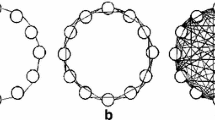Abstract
In this paper, an attempt has been made by incorporating some special features in the conventional particle swarm optimization (PSO) technique for decentralized swarm agents. The modified particle swarm algorithm (MPSA) for the self-organization of decentralized swarm agents is proposed and studied. In the MPSA, the update rule of the best agent in swarm is based on a proportional control concept and the objective value of each agent is evaluated on-line. In this scheme, each agent self-organizes to flock to the best agent in swarm and migrate to a moving target while avoiding collision between the agent and the nearest obstacle/agent. To analyze the dynamics of the MPSA, stability analysis is carried out on the basis of the eigenvalue analysis for the time-varying discrete system. Moreover, a guideline about how to tune the MPSA's parameters is proposed. The simulation results have shown that the proposed scheme effectively constructs a self-organized swarm system in the capability of flocking and migration.
Similar content being viewed by others
References
Anderson, G.T., Clark, M.R.: Navigation of autonomous robots with an intelligent Oscillator Controller. In: Proc. of the IEEE/ASME Int. Conf. on Advanced Intelligent Mechatronics, pp. 1003–1007 (1999)
Balch, T., Hybinette, M.: Behavior-based coordination of large-scale robot formations. In: Proc. Fourth Int. Conf. on Multi Agent Systems, pp. 363–364 (2000)
Beni, G.: The concept of cellular robotic system. In: IEEE Int. Symp. on Intelligent Control, pp. 57–62 (1998)
Carlisle, A., Dozier, G.: Adapting particle swarm optimization to dynamic environments. In: Proceedings 2000 ICAI, Las Vegas, Nevada, vol. I, pp. 429–434 (2000)
Clark, M.R., Anderson, G.T.: Coupled Oscillator control of autonomous mobile robots. Auton. Robots 9, 189–198 (2000)
Eberhart, R., Shi, Y.: Comparison between genetic algorithms and particle swarm optimization. In: The 7th Annual Conf. on Evolutionary Programming, pp. 611–616 (1998)
Fukuyama, Y., et al.: A particle swarm optimization for reactive power and voltage control considering voltage stability. In: Proc. of IEEE Int. Conf. on Intelligent System Application to Power Systems (ISAP), Rio de Janeiro, April 1999
Horn, R.A., Johnson, C.R.: Matrix Analysis. Cambridge University Press, Cambridge, UK, (1985)
Jin, K., Liang, P., Beni, G.: Stability of synchronized distributed control of discrete swarm structures. In: IEEE Int. Conf. on Robotics and Automation, pp. 1033–1038 (1994)
Kennedy, J.: The particle swarm: social adaptation of knowledge. In: Proc. of IEEE Int. Conf. on Evolutionary Computation, pp. 303–308 (1997)
Kennedy, J., Eberhart, R.: Particle swarm optimization. In: Proc. IEEE Int. Conf. Neural Networks, vol. 4, pp. 1942–1948 (1995)
Kennedy, J., Spears, W.: Matching algorithms to problems: An experimental test of the particle swarm and some genetic algorithms on the multimodal problem generator. In: IEEE Int. Conf. on Evolutionary Computation, pp. 78–83 (1998)
Kim, D.H.: A swarm system design based on coupled nonlinear oscillators for cooperative behavior. Int. J. Control. Autom. Syst. 1(3), 301–307 (2003)
Levine, H., Rappel, W., Cohen, I.: Self-organized in systems of self-propelled particles. Phys. Rev. E 63, 017101(4) (2001)
Liang, P. and Beni, G.: Robotic morphogenesis. In: IEEE Int. Conf. on Robotics and Automation, pp. 2175–2180 (1995)
Mogilner, A., Edelstin-Keshet, L.: Spatio-angular order in population of self-aligning objects: Formation of oriented patches. Physica D 89, 346–367 (1996)
Nolfi, S., Floreano, D.: Evolutionary Robotics. MIT, Cambridge, MA (2000)
Parker, L.E.: Cooperative robotics for multi-target observation. Intelligent Automation and Soft Computing, special issue on Robotics Research at Oak Ridge National Laboratory 5(1), 5–19 (1999)
Reynolds, C.W.: An evolved vision-based behavioral model of coordinated group motion. In: Meyer, J.-A., Roiblat, H.L., Wilson, S. (eds.) From Animals to Animals 2, pp 384–392. MIT, Cambridge, MA (1982)
Reynolds, C.W.: Flocks, herds and schools: A distributed behavioral model. Comput. Graph. 21(4), 25–34 (1987)
Selvan, S.E., Subramanian, S., Solomon, S.T.: Novel technique for PID tuning by particle swarm optimization. In: Seventh Annual Swarm Users/Researchers Conference, http://www.nd.edu/~swarm03/ (2003)
Shi, Y.H., Eberhart, R.C.: A modified particle swarm optimizer. In: Proc. of IEEE Int. Conf. on Evolutionary Computation, pp. 69–73 (1998)
Werger, B.B., Mataric, M.J.: Broadcast of local eligibility for multi-target observation. In: Proc. on Distributed Autonomous Robotic Systems, pp. 347–356 (2000)
Yasuda, K., Ide A. and Iwasaki, N.: Adaptive particle swarm optimization using velocity information of swarm. In: Proceedings of IEEE International Conference on Systems, Man and Cybernetics, pp. 3475–3481 (2004)
Author information
Authors and Affiliations
Corresponding author
Additional information
Category (5) – Intelligent Systems / Intelligent Control / Fuzzy Control / Prosthetics / Robot Motion Planning
Rights and permissions
About this article
Cite this article
Kim, D.H., Shin, S. Self-organization of Decentralized Swarm Agents Based on Modified Particle Swarm Algorithm. J Intell Robot Syst 46, 129–149 (2006). https://doi.org/10.1007/s10846-006-9047-3
Received:
Accepted:
Published:
Issue Date:
DOI: https://doi.org/10.1007/s10846-006-9047-3




